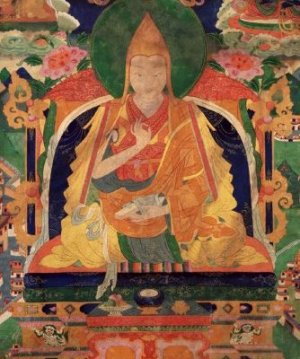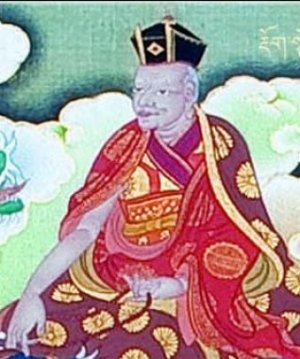| Library / Biographies |
Dampa Sönam Gyaltsen Biography

Lama Dampa Sönam GyaltsenSönam Gyaltsen, the Sakya Lama Dampa (1312-1375) was a ruler of the Sakya school of Tibetan Buddhism, which had a precedence position in Tibet under the Yuan dynasty.
He is considered the greatest Sakya scholar of the 14th century and served as ruler for a short term in 1344-1347.
Sönam Gyaltsen, usually just known by his title, "Lama Dampa", was one of the thirteen sons of the abbot-ruler (dansa chenpo) Zangpo Pal who governed from 1306 to 1323 and therefore had a key position in the politics of Tibet under the overlordship of the Yuan emperor.
His original name was Nyima Dewa'i Lotro; he received the name Sönam Gyaltsen when he was ordained as a novice monk in 1328. In 1331, at 19 years of age, he became a fully ordained.
He studied with Namkha Lekpai Gyeltsen (1290-1364), Dolpopa Sherab Gyeltsen (1292-1361), Gyelse Tokme Zangpo (1295-1369), and Buton Rinchen Drub (1290-1364) who gave him the Kālacakra1 empowerment.
While Lama Dampa's involvement with Tibetan politics was of little consequence, his cultural efforts were more impressive. He had been the religious teacher of Changchub Gyaltsen who eventually united Central Tibet under a new independent regime, the Phagmodrupa dynasty.
Although the two men found themselves in opposing camps, they shared an interest in reviving the ideals of the old Tibetan Empire (c. 600-842).
Some years after his abdication, Lama Dampa spent time and effort restoring Samye, the monastery associated with the old kings, which had been reduced to ruins during the fighting that preceded the Phagmodrupa victory.
He subsequently authored a pseudo-historical work, Clear Mirror on Royal Genealogy (1368), where the historical details about the ancient kings were overlaid with Buddhist embellishments.
The style of the narrative tended to retrospectively tone down the Chinese influences on Tibet which had accompanied the period of Mongol overlordship.
This made a great impact on the Tibetan view of their ancient history and supported Tai Situ Changchub Gyaltsen's project of national renewal.
He was a master in the Ngok lineage2 of the Prajñāpāramitā. Notable are his commentaries on the Bodhisattvacaryāvatāra, Pramāṇavārttika, Abhisamayalankara, and Nagarjuna's treatises, as well as his work with Dölpopa Shérap Gyeltsen on the shentong3 theory of the two truths doctrine.4
His students included Rendawa Zhonnu Lodro (1349-1412); Tsongkhapa Lobzang Drakpa (1357-1419) and Longchenpa Rabjam Drime Ozer (1308-1364). He also taught and conferred initiations on Tai Situ Changchub Gyeltsen, the military and political figure whose reign initiated the Pakmodrupa Dynasty.
Lama Dampa died as a highly respected scholar in 1375.
Sources
• https://en.wikipedia.org
• https://treasuryoflives.org
• https://www.rigpawiki.org
Footnotes
1. Kālacakra is a multiple meanings term in Vajrayana Buddhism. It literally means "wheel of time" or "time cycles". "Kālacakra" is also the name of a series of Buddhist texts and a major practice lineage in Indian Buddhism and Tibetan Buddhism. The tantra is considered to belong to the unexcelled yoga (anuttara-yoga) class.
Kālacakra also refers both to a patron tantric deity or yidam in Vajrayana and to the philosophies and yogas of the Kālacakra tradition. The tradition's origins are in India and its most active later history and presence has been in Tibet. The tradition contains teachings on cosmology, theology, philosophy, sociology, soteriology, myth, prophecy, medicine, and yoga. It depicts a mythic reality whereby cosmic and socio-historical events correspond to processes in the bodies of individuals. These teachings are meant to lead to a transformation of one's body and mind into perfect Buddhahood through various yogic methods.
The Kālacakra tradition is based on Mahayana Buddhist non-dualism, which is strongly influenced by Madhyamaka philosophy, but also draws on a wide range of Buddhist and non-buddhist traditions (such as Vaibhasika, Shaivism, Vaishnavism and Samkhya). Kālacakra remains an active tradition of Buddhist tantra in Tibetan Buddhism, and its teachings and initiations have been offered to large public audiences, most famously by the 14th Dalai Lama, Tenzin Gyatso.
2. Ngok Choku Dorje (1036–1102) was the principal recipient of Marpa's explanatory lineages and particularly important in Marpa's transmission of the Hevajra Tantra. Ngok Choku Dorje founded the Langmalung temple in the Tang valley of Bumthang district, Bhutan - which stands today. The Ngok branch of the Marpa Kagyu was an independent lineage carried on by his descendants at least up to the time of the Second Drukchen Gyalwang Kunga Paljor (1428-1476) who received this transmission, and 1476 when Go Lotsawa composed the Blue Annals.
3. Rangtong and shentong are two distinctive views on emptiness (sunyata) and the two truths doctrine within Tibetan Buddhism. Rangtong ("empty of self-nature") is a philosophical term in Tibetan Buddhism that is used to distinguish the majority Madhyamaka teaching on the meaning of śūnyatā or "emptiness", namely that all phenomena are empty of an enduring and/or unchanging essence or "self," and that this emptiness is not an absolute reality, but a mere nominal characterization of phenomena. It is related to the prasangika approach, which argues that no syllogistic forms of reasoning should be used to debate the notion of inherent existence, but only arguments which show the logical implications and absurdity of positions based upon inherent existence. This position is the mainstream Gelugpa interpretation of Madhyamaka, one of the main Mahayana schools, which dominates Vajrayana Buddhism.
Shentong (also transliterated zhäntong or zhentong; literally "other-emptiness") is a position within Tibetan Madhyamaka. It applies śūnyatā in a specific way, agreeing that relative reality is empty of self-nature, but stating that absolute reality (Paramarthasatya) is "non-dual Buddhajnana" and "empty" only of "other," relative phenomena, but is itself not empty and "truly existing." This absolute reality is described by positive terms, an approach which helps "to overcome certain residual subtle concepts" and "the habit [...] of negating whatever experience arises in his/her mind." It destroys false concepts, as does prasangika, but it also alerts the practitioner "to the presence of a dynamic, positive Reality that is to be experienced once the conceptual mind is defeated.
4. The Buddhist doctrine of the two truths differentiates between two levels of satya (a Sanskrit and Pali word meaning truth or reality) in the teaching of the Buddha: the "conventional" or "provisional" (saṁvṛti) truth, and the "ultimate" (paramārtha) truth.





